December 10, 2019
 by Chintan Zalani / December 10, 2019
by Chintan Zalani / December 10, 2019

About a decade ago, blogging was becoming mainstream and transforming into a lucrative money-making opportunity.
Soon enough businesses realized that they could also create a business blog, share their brand story, and build an audience. The contemporary content marketing industry had started taking shape.
Fast forward to 2019, and Google trends show that the interest in content marketing has crossed blogging.
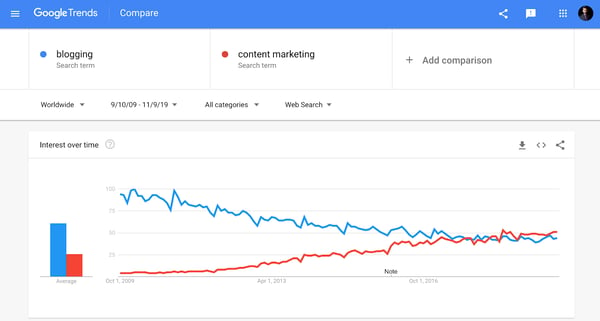
Even though content has become a proven marketing channel and business processes have been established, a few myths around content marketing stay afloat. They hurt the bottom line of companies and negatively affect the results of your content campaigns.
Here’s a list of five such myths with actionable strategies by skilled practitioners for tackling them.
Do you still rely on an intern to write articles for your blog? Are the subjects of your blog posts based on your interests and loose intuition?
Then you might fail to create engaging content that holds the attention of your target audience. That means you’ll neither build trust nor long-term relationships with your readers (customers and non-customers).
Ah.
I’m sure you want your content marketing efforts to affect the company’s bottom line positively. Given the fierce competition in the content landscape, it will be difficult to survive without documenting your strategy.
Before writing another piece, document your strategy and tie lightweight metrics (like total visitors, organic traffic, and keyword rankings, and the like) to measure your performance. Creating a cohesive plan makes content marketing a priority. It means you can hold your employee(s) accountable for the content program.
In their 2020 B2B Content Marketing Research, Content Marketing Institute found that one-third (32%) of their surveyed organizations lack a full-time person dedicated to content marketing. However the number drops to 13% for the best. Forty-four percent of top-performing B2B marketers report a centralized structure for their content marketing efforts.
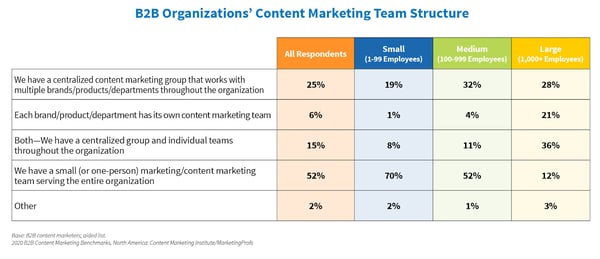
| Actionable: Document your content strategy and ensure that your efforts are tied with marketing KPIs like traffic, leads generated, and revenue. Start with defining the attributes of your ideal customer, identifying their pain points, and understanding their decision-making process. Understanding your audience will unlock their informational needs and enable you to craft persuasive content based on your customer’s buying journey. Both of these aspects are prevalent in top performing B2B content marketers. |
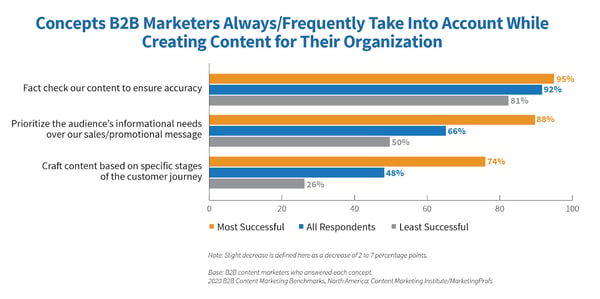
You should also structure your content team. Generally it begins with one person from your company taking responsibility for the complete funnel (with the help of freelance content creators).

However it can evolve into a full-fledged department containing four to five people. For instance, HubSpot has a dedicated content team.
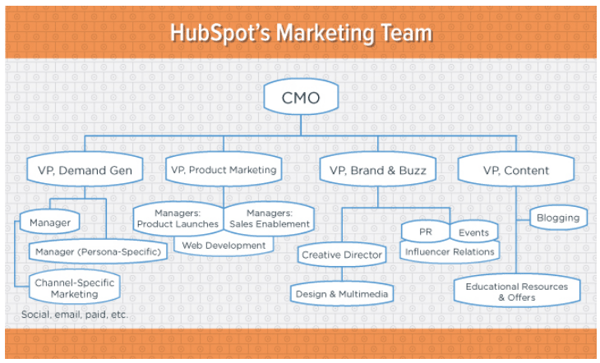
G2 has also shared how they found and retained a world-class content marketing team that delivered 1M organic visits in a year. Here’s a checklist you can refer to for getting started.
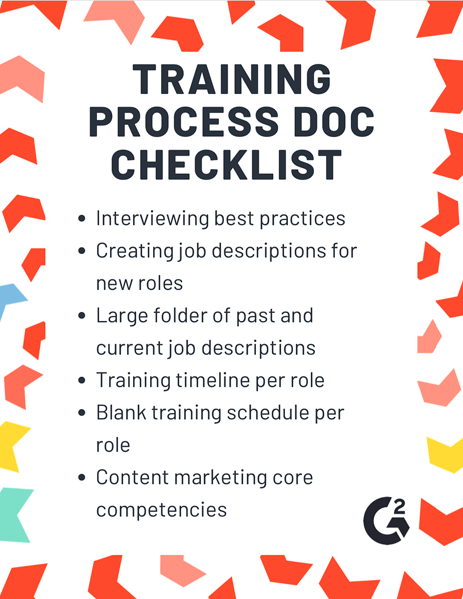
Most B2B content strategies are targeting the top of the funnel to create brand awareness.
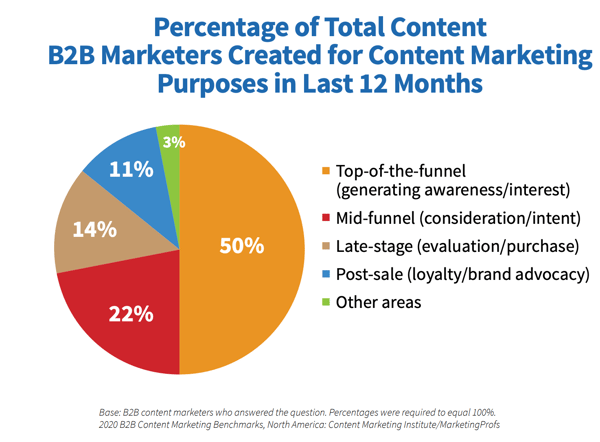
However if you’re starting out a new content campaign, you can also prioritize the bottom of the funnel. This would mean starting with creating white papers, a help center, case studies, microsites, articles on branded keywords, and the like.
As Kevin Indig, VP SEO & Content at G2, highlights here, bottom of the funnel prioritization can prove more effective!
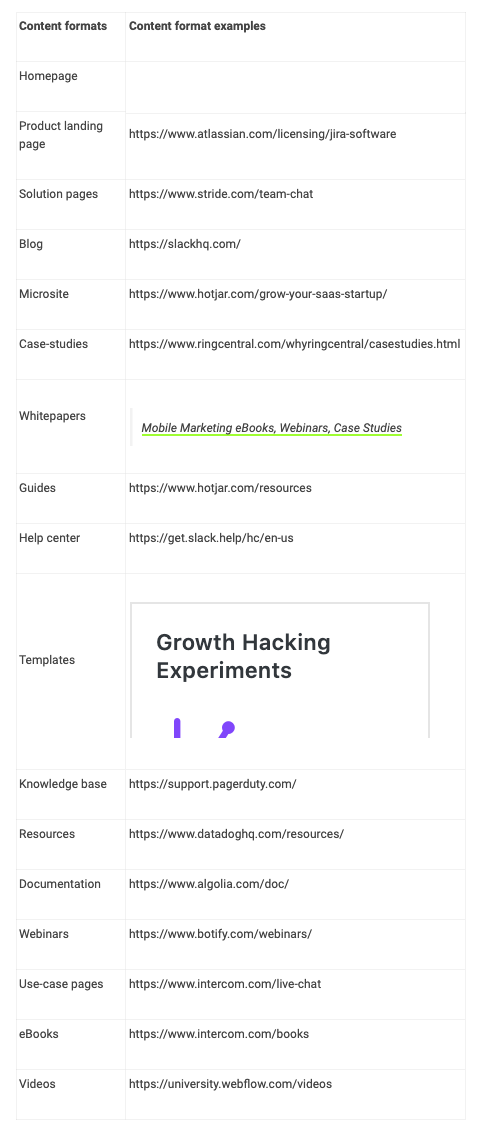
Once you prove the C-suite that content marketing is driving business results, it’s easier to get the buy-in for creating broader brand awareness based content targeting competitive keywords. The above strategy also ensures that you gobble up domain authority to tackle such campaigns.

In the last decade, we’ve seen an explosion in the amount of content produced by businesses and individual bloggers. The reason is that 60% of marketers create one piece of content per day.
Now, almost all industries and niches have excellent creators that have raised the bar on content quality. If you want some inspiration, then check out these copywriting examples compiled by yours truly!
In the more competitive B2B niche, there’s such intense competition that 800-word articles might convey your ideas, but fail to rank.
Here’s how Jimmy Daly, the Director of Marketing at Animalz, puts it.
"The article should be as long as it needs to be."
— Jimmy Daly (@jimmy_daly) May 14, 2019
Good advice, but most content marketers throw this out the window when they see that long stuff ranks well.
Most ideas can be conveyed in short articles, but most keywords actually do require longer content to rank.
But even after you take multiple days to write SUPER long and high-quality articles, it’s not sufficient to drive traffic.
Take it from Vukasin Vukosavljevic, the head of growth at Lemlist. He held onto the belief that creating quality content is enough.
Vukosavljevic notes:
“I thought if I put in the work to create something that's actionable and valuable, I'm going to win. It didn't quite work like that, EVER. The reality is that once an epic piece of content is in the bag, the real game begins. It's called distribution, and it goes far beyond your SEO needs. Distribution is the ability to position that piece of content for long-term success on many different platforms and in all kinds of formats. For me, this kind of skill is an absolute art.”
As a creator, you should keep the primary distribution channel in mind before you begin your creation.
Alex Birkett, Senior Growth Marketing Manager at HubSpot, chimes in:
"Though I'm sure the occasional successful accident happens, the best performing content is created with promotion in mind and promotable assets built into it. In the vast majority of cases, the primary channel you should have in mind is search, which could then bifurcate into two further lanes: the rankable and the linkable (not necessarily mutually exclusive). If you want to create something linkable, then it needs to appeal to those who can link to it.”
Birkett continues how to write something that gets links:
“There will always be an element of uncertainty in what these gatekeepers and link givers will want to link to, but you can identify that by noticing what they've linked to in the past and trying to carve out an impressive piece of content in a similar vein.”
You can use Ahrefs for finding such most-linked content pieces.
While Alex doesn’t mention how to write content that ranks, you can take lessons from how G2 dominated SERPs with their content.
| Actionable: Content marketing only works when you put ample time in distributing the content you create. It entails promoting your pieces in relevant communities, performing outreach to build backlinks, and running paid advertisements. |
Here’s how bloggers are typically driving traffic to their posts as per the annual survey by Orbit Media.
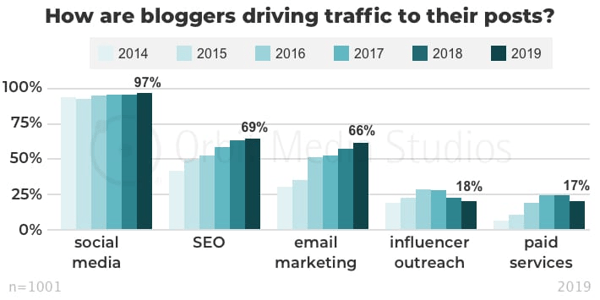
The lesser popular promotional channels (influencer marketing and paid services) also require more effort and are more likely correlated with “strong results.”

|
Related: Need some content inspiration? Read G2's guide on 10 types of content to help you push your brand and blog to greater levels of success in the coming year! |
For businesses getting started with content marketing, an estimated commitment of six months is scary. It becomes even unbelievable that this kind of marketing will work you when you find that it calls for letting go of direct promotions and biases towards your brand in your content.
How can a new business invest thousands of dollars every single month to build a team of writers/marketers in the hope of driving results three to six months later?
It’s tricky, and fears loom over:
|
For content marketing to work, you need to take that leap of faith. If you’re from a traditional product promotion background, it might make you uncomfortable to not interrupt people for getting their attention.
However remember the content marketing adage as Rand Fishkin puts it: content marketing is about building familiarity, trust, and a relationship with your audience.
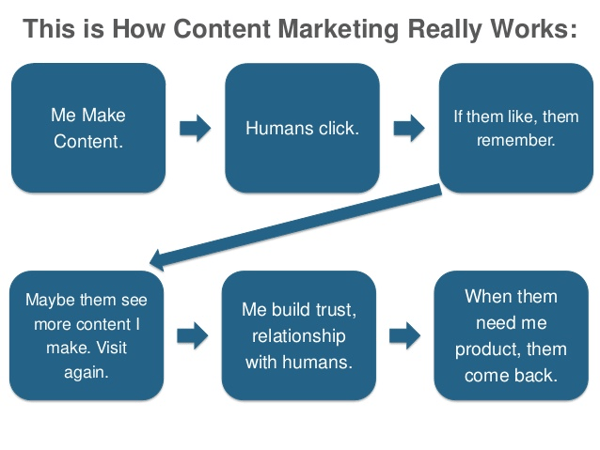
Traditionally journalism norms called for a clear separation between the editorial and business activities of a news organization. However we no longer live in a time of separation between the two. And as a content marketer, you’ve to meet business goals through content.
But it’s not ideal to rank your marketing product at the top in your listicle post of marketing tools. That’s what Jordan Teicher, the Editor in Chief at Contently, told me when I reached out to him. He also shared an alternative: don’t simply claim you’re good – show it.
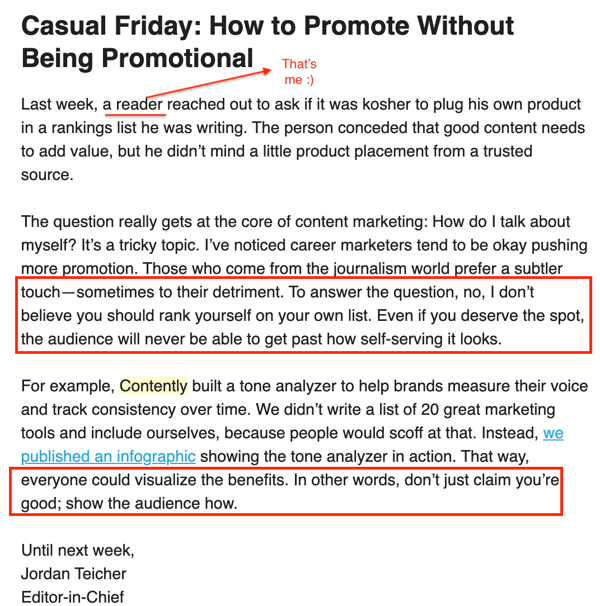
| Actionable: As a brand, you need need to tie content marketing with KPIs and ensure it’s delivering a healthy ROI. However overtly promoting your product in your content will turn off your audience. For creating broader brand awareness through your content, you can include screenshots of your product where contextually relevant to the advice. |
Ahrefs is a master at this tactic. Look at how they linked to “Ahrefs Site Explorer” in their article on Quora marketing.
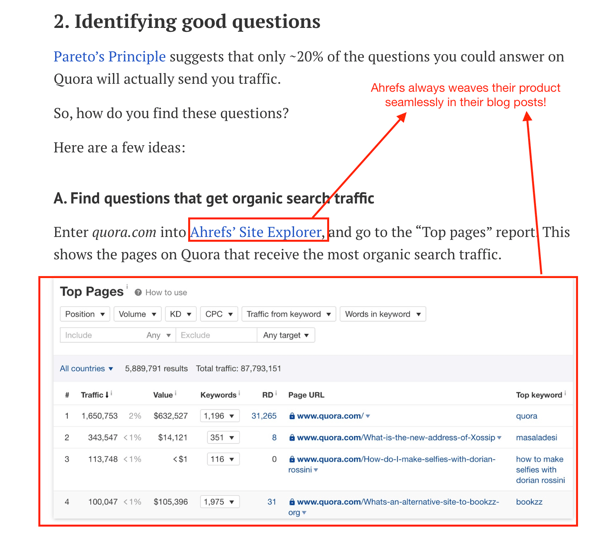
I got in touch with Si Quan Ong, Customer Success Manager at Ahrefs, to expand on how they manage to weave their product seamlessly.
He responded with the following five key factors:
| 1. “We have a great product that solves many issues and challenges for our customers. So writing about those issues and challenges naturally allows us to write about our product.” 2. “We don't view our blog as a ‘marketing’ or ‘SEO’ blog, but rather the ‘SEO blog by Ahrefs.’ Yes we write about those topics, but it is our blog and therefore, it is natural to expect us to talk about our product.” 3. “We don't always talk about our product. Where possible, we're not afraid to recommend other tools that are free, simpler to use, and the like. 4. “Our content is written to provide value, which naturally involves our product. It is not written to promote our product only specifically. I think that's the key difference.” 5. “There is a specific way we write that can help pinpoint use cases where our product can help. It comes from our knowledge of the industry, knowledge of our product, and lots of research.” |
Quan concludes with the following piece of advice for content marketers (valid for content marketers selling products):
“I find that many content marketers are separate from the product management and development process, and in most cases, they don't even use their own product. But as a content marketer, you should always be talking to their customers, testing and using their own product, and not simply writing about disparate topics that have nothing to do with their company.”
In its annual survey, Orbit Digital Media found that a minor percentage of bloggers publish daily, and 67% that do so report “strong results.”
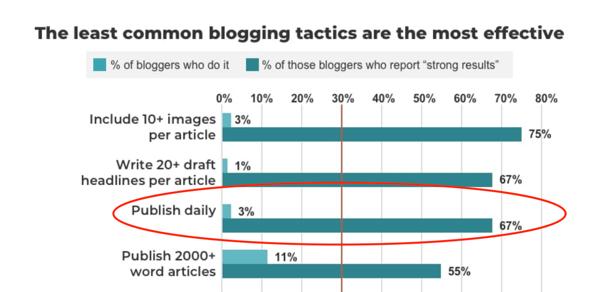
While these self-reported results seem impressive, the idea of publishing content every day is overwhelming and impossible for most businesses. Most subjects require dedicated writing and editing efforts spanning multiple days across multiple team members. It’s difficult to sustain such a cadence without compromising on quality or tiring your audience.
What further aggravates the strategy of ‘publishing every day’ is the ‘best practice’ of being active on every social media platform. Don’t get fooled by marketing gurus that seemingly appear active on five to 10 platforms every day. They have taken multiple years to reach there.
Further they have dedicated teams that post on these social media platforms. For instance, Gary Vaynerchuk relies on his content pyramid strategy to distribute his content. He had a 16-member group called TeamGary (as of 2017) that contributed to managing his social presence.
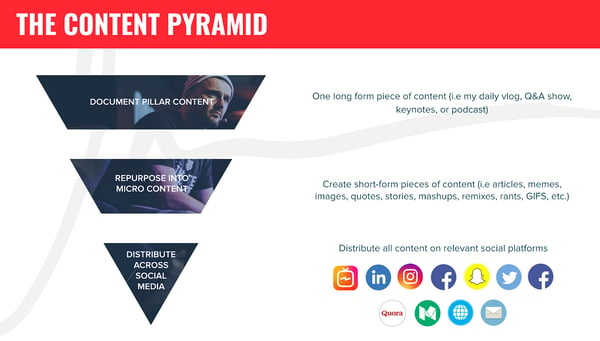
If you’re a small company, publishing daily blog posts and attacking multiple platforms isn’t the best use of your resources. There’s so much content noise that it’s difficult to stand out without stellar quality.
Adam Enfroy, an affiliate marketer and full-time blogger, tells us an alternate strategy:
“With four million blog posts published daily, content creators think they need to churn out new articles consistently to compete. However I believe that content quality trumps quantity every time. Rather than focusing on publishing X pieces per week, concentrate on getting X articles to rank on search engines. The way this occurs most of the time is by updating and improving your current content rather than publishing new content.
Every article on my blog that ranks on page one of Google may have started at 2,000 words. But every single one has been updated, tweaked, and increased to 3,000, 4,000, or 5,000+ words over time. By focusing your efforts on a smaller amount of epic pieces rather than a large number of mediocre articles, you'll see better returns in the long run.”
Arto, the founder of 10Web, tells a simple formula for focusing your content marketing efforts:
“Understand who is your ideal customer and where they hang out. It will lead you to the platform you should use in order to reach them. After that, you can test and see how many posts you need to make on each platform. For example, posting every single day does not work with LinkedIn; 2-3 posts per week is quite enough.”
Also unless you have a specialized team (or reason), begin with textual content format. It’s proven to deliver results and easier to execute compared with more intricate visual formats like video.
Long content always ranks better.
Including influencers can catapult the reach of your content pieces. Only pursue data-backed marketing. Include power words in your headlines. Conduct and publish original research that shows what’s working in your industry.
If you’ve read a few “ultimate guides” and worked in marketing for a while, you might have already arrived at many such highly effective content tactics. They are guised as “best practices," and they are supposed to deliver business results as soon as you execute them.
The problem with these practices? They are based on what’s new/trending, are fairly common (read as “being average”), and might even conflict with each other. Read all kinds of marketing literature with a grain of salt because it doesn’t directly tell you what's best for you.
Ask questions like the ones below:
| Actionable: In a sea of noisy content, following best practices on length, headline type, and relying on SEO tools will only take you so far. To stand out, add a pinch of your personality to your content and come up with creative angles. For the marketing blog posts you read, look at the context under which the advice is shared. Check if the strategy aligns with your skillset. |
If you’re on the fence about content marketing, then understand that it requires a long-term commitment. There’s going to be a considerable lag between launching your campaign and attributing revenue to it. However the business results you achieve will compound over time.
The above list of content marketing myths will help you make a more informed decision and prevent you from committing common mistakes.
As you navigate away from the above content marketing myths, dive into G2's rundown of the current content marketing software on the market. See which one will help you achieve the highest level of success as 2020 rolls around!
Chintan is a writer and an ROI-focused content marketer. You can get in touch with him at Elite Content Marketer if you want to grow your business through content.
In the last two decades, the SaaS market has exploded.
 by Chintan Zalani
by Chintan Zalani
In some ways, gated content relies on that old cliche: you want what you can’t have.
 by Lizzie Kardon
by Lizzie Kardon
Behind every purchase a consumer makes, there is a decision-making journey.
 by Ryan Prior
by Ryan Prior
In the last two decades, the SaaS market has exploded.
 by Chintan Zalani
by Chintan Zalani
In some ways, gated content relies on that old cliche: you want what you can’t have.
 by Lizzie Kardon
by Lizzie Kardon


